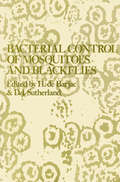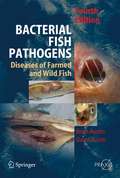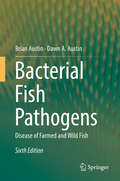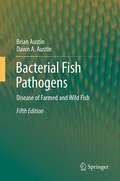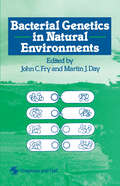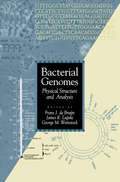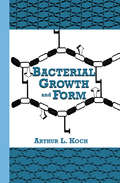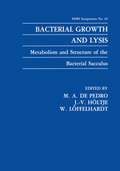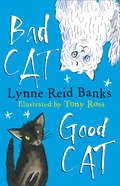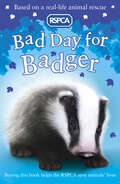- Table View
- List View
Bacterial Control of Mosquitoes & Black Flies: Biochemistry, Genetics & Applications of Bacillus thuringiensis israelensis and Bacillus sphaericus
by Huguette De Barjac Donald J. SutherlandMosquitoes and black flies are a constant threat to health and comfort, yet the modern chemical pesticides used to control them have cre ated serious ecological problems. Populations of resistant mosquitoes and black flies have evolved, beneficial insects and natural predators have been destroyed, and environmental pollution has increased worldwide. Therefore, scientists have energetically sought new, environmentally safe technologies to combat mosquitoes and black flies and the diseases they carry. Among the most effective alternative means of controlling these pests are the highly spe cific microbial agents derived from Bacillus tburingiensis or Bacillus spbaericus. The microbial control of mosquitoes and black flies is a very important, rapidly developing area of science. Entomologists and microbiologists have already achieved spectacular successes using B. tburingiensis and B. spbaericus against these pests. Recent discoveries of new bacterial isolates specific to new hosts and recent genetic improvements in these isolates have created the potential for wide-scale use of these biological control agents. Efficient microbial control of mosquitoes and black flies can now be achieved, but a proper knowledge of factors relating to the safe and effective use of these biological control agents is necessary. The efficacy of B. tburingiensis and B. spbaericus is influenced by the inherent differential tol erance of the target mosquitoes or black flies, by the formulation technology and application of these agents, and by environmental factors, especially sun light and temperature.
Bacterial Diversity and Systematics (F.E.M.S. Symposium Series #75)
by B. J. Tindall AlbertoRamos-Cormenzana Fergus G. PriestBacterial taxonomy as a specialized discipline is practised by a minority but the applications of taxonomy are important to most, if not all microbiologists. It is the implementation of taxonomic ideas and practises which gives rise to identification and typing systems, procedures for the analysis and characterization of biodiversity, hypotheses about the evolution of micro-organisms, and improved procedures for the isolation and implementation of bacteria in biotechnological processes. Without taxonomic theory providing a sound basis to these many facets of microbiology there would be severe problems faced by many scientists working with micro-organisms. Taxonomy comprises three sequential but independent processes; classification, nomenclature and identification. The first two stages are the prime concern of the specialist taxonomist but the third stage should result in identification schemes of value to all microbiologists. As the classification and identification of micro-organisms improves, largely due to the introduction of new technologies, so does its contribution to the subject as a whole. It therefore seemed timely to hold a conference in the autumn of 1993 devoted to microbial identification. Such a topic could not be addressed without some reference to the enabling discipline of classification, but the principal aims were to assess improvements in identification and typing and how these were benefiting microbiological topics ranging from ecological and biotechnological studies of extremophilic bacteria to the use of pyrolysis mass spectrometry in epidemiology. The meeting, which was held in Granada, Spain, was supported by FEMS (FEMS Symposium No.
Bacterial Fish Pathogens: Disease of Farmed and Wild Fish (Springer Praxis Books)
by B. Austin D.A. AustinThis revised edition fills the need for an up-to-date comprehensive book on the biological aspects of the bacterial taxa which cause disease in fish. Since the 3rd edition was published in 1999, much has changed in the control of disease of farmed and wild fish. This book analyses all the new information, including that on new pathogens and new developments on long established diseases, such as furunculosis and vibriosis. Consideration is given to all of the bacterial taxa which have at some time been reported as fish pathogens, whether they are secondary invaders of already damaged tissue or serious, primary pathogens.
Bacterial Fish Pathogens: Disease of Farmed and Wild Fish (Springer Praxis Books / Aquaculture And Fisheries Ser.)
by Brian Austin Dawn A. AustinThis book puts emphasis on the isolation, taxonomy, diagnosis (phenotypic, serology and molecular biology), epizootiology, pathogenicity mechanisms, and methods of disease control (by vaccination, immunostimulation, probiotics, prebiotics, plant products, and antimicrobial compounds. Co-infections, which are attributed to more than one microbial species have been discussed. Shortcomings in knowledge have been highlighted. This sixth edition is the successor to the original version, first published in 1987, and which fills the need for an up-to-date comprehensive text on the biological aspects of the bacterial taxa which cause disease in finfish. The book is primarily targeted at researcher workers, including postgraduate students, and diagnosticians. It is anticipated that the readership will include veterinary microbiologists, public health scientists and microbial ecologists.
Bacterial Fish Pathogens: Disease of Farmed and Wild Fish
by Brian Austin Dawn A. AustinThis completely updated fifth edition of Bacterial Fish Pathogens is a comprehensive discussion of the biological aspects of the bacteria which cause disease in farmed and wild fish. Since the 4th edition was published in 2007, there has been an upturn in the application of molecular approaches to taxonomy, diagnosis and vaccine development. New pathogens, e.g. Aeromonas schubertii, have been described. Also, there has been the emergence of diseases caused by bacteria which have not been cultured, and which have been equated with new taxa, i.e. ‘Candidatus’. Consideration is given to all the bacterial fish pathogens, including primary pathogens and opportunists.
Bacterial Genetics in Natural Environments
by J. C. Fry M. J. DayThis book has arisen from the Second European Meeting on Bacterial Genetics and Ecology (Bageco-2) held at the University of Wales, College of Cardiff which we organised on 11-12 April 1989. The meeting was attended by some 60 participants from eight European countries and was made possible by partial financial support from the Commission of the European Communities (CEC) and Imperial Chem ical Industries (UK) Ltd. The meeting was organised to discuss modern developments in the genetics of bacteria in aquatic and terrestrial habitats. It followed on from, and complemented, the first meeting of this series organised by Jean-Pierre Gratia in Brussels during April 1987 which concentrated more on medical and epidemiological issues. ! The next meeting will be organised by Michel J. Gauthier in 1991 at Nice, France. If you have been fired with enthusiasm for ecological bacterial genetics after having read this book, and want to attend the next meeting but did not hear about the one in Cardiff, you should write to Dr Gauthier to be put on the address list. A lot is now known about bacterial genetics at the physiological, biochemical and molecular level, and bacterial ecology has developed rapidly over the last 20 years. However, until very recently, few researchers have crossed the divide and linked these two specialisms.
Bacterial Genomes: Physical Structure and Analysis
by Frans De Bruijn James R. Lupski G. M. WeinstockA wide range of microbiologists, molecular biologists, and molecular evolutionary biologists will find this new volume of singular interest. It summarizes the present knowledge about the structure and stability of microbial genomes, and reviews the techniques used to analyze and fingerprint them. Maps of approximately thirty important microbes, along with articles on the construction and relevant features of the maps are included. The volume is not intended as a complete compendium of all information on microbial genomes, but rather focuses on approaches, methods and good examples of the analysis of small genomes.
Bacterial Growth and Form
by A.L. KochBased on the author's more than 40 years experience, Bacterial Growth and Form examines such important questions as what bacteria were, what they are, and what they do. Particular emphasis is placed on the ability of bacteria to establish their shapes as they grow and divide. By developing an understanding of the properties of these simple and early life forms, especially at the levels of physics and mathematics, the book provides insight into the mechanism used by bacteria to subvert physical forces to their own ends. A major consideration of this work is that prokaryotes do many of the same things that eukaryotes do, but with simpler equipment employed in an extremely sophisticated way. The book illustrates this point by closely examining the basic mechanismof hydrostatic or turgor pressure: how it functions for many of the mechanical purposes in the prokaryote, how it leads to mechanisms for resisting turgor pressure, and how it ultimately led to the development of exoskeletons and endoskeletons, and to the refinement of bacteria. Bacterial Growth and Form brings together biochemical, biophysical, and physiological principles in an authoritative, single-source volume. It provides researchers, and students in biophysics and microbiology with an indispensible reference and a new perspective into the biology of life.
Bacterial Growth and Lysis: Metabolism and Structure of the Bacterial Sacculus (F.E.M.S. Symposium Series #65)
by M. A. De Pedro J. V. Höltje Wolfgang LöffelhardtThis volume is based on a FEMS Symposium entitled "Bacterial Growth and Lysis: Metabolism and Structure of the Bacterial Sacculus" held at the Monastery of Lluc (Mallorca, Spain) on 5-10 April, 1992. The goals of the symposium were to assess the present state of knowledge on the structure and physiology of the bacterial murein sacculus, and to develop new hypotheses and strategies to promote further development of the field. Consequently, the contributions compiled in this volume include broadly different approaches, from the introduction of new analytical methods to the presentation of provocative models for cell wall growth and division. Structural, biochemical, and genetic aspects are widely covered with special emphasis on the enzymology and regulation of murein hydrolases (autolysins). Comprehensive reviews on bacterial S layers and yeast cell walls are included to stimulate conceptual cross-feeding with these closely related topics. We believe that this book will provide the reader with a useful and up-to-date review of the topic. We would feel deeply rewarded by any positive influence this book may have on the future progress of the field, whereby all the scientific credit for it should be given to the authors of the excellent contributions presented.
Bacterial Invasion into Eukaryotic Cells: Subcellular Biochemistry (pdf) (Subcellular Biochemistry #33)
by Tobias A. Oelschlaeger Jörg H. HackerThe Bacteriophages: Volume 1 (The Viruses)
by Richard CalendarIt has been 10 years since Plenum included a series of reviews on bacte riophages, in Comprehensive Virology. Chapters in that series contained physical-genetic maps but very little DNA sequence information. Now the complete DNA sequence is known for some phages, and the se quences for others will soon follow. During the past 10 years two phages have come into common use as reagents: A phage for cloning single copies of genes, and Ml3 for cloning and DNA sequencing by the dideoxy termi nation method. Also during that period the use of alternative sigma fac tors by RNA polymerase has become established for SPOl and T4. This seems to be a widely used mechanism in bacteria, since it has been implicated in sporulation, heat shock response, and regulation of nitro gen metabolism. The control of transcription by the binding of A phage CII protein to the -35 region of the promoter is a recent finding, and it is not known how widespread this mechanism may be. This rapid progress made me eager to solicit a new series of reviews. These contributions are of two types. Each of the first type deals with an issue that is exemplified by many kinds of phages; chapters of this type should be useful in teaching advanced courses. Chapters of the second type provide comprehensive pictures of individual phage families and should provide valuable information for use in planning experiments.
Bacteriophages: Practical Applications for Nature's Biocontrol
by Sabah A.A. Jassim Richard G. LimogesBacteriophages: Practical Applications for Nature's Biocontrol' presents the latest information on uses in healthcare settings as well as animal husbandry, management and care of farm animals by using enhanced phages to replace antibiotics for growth promotion in animal feed or to prevent, control and treat disease in animals. The book will provide an overview of the function of phages and what researchers need to know, from phage hunting to laboratory design, management, production and application using different tools and methods. These key aspects will be discussed through a series of dedicated chapters, with topics covering auditing, validation, data analysis, microbial identification, culture media, and contamination control, etc.
The Baculoviruses (The Viruses)
by Lois K. MillerThe past decade has witnessed an explosion of information on the molecular biology of insect viruses and a frenzy of activity in applying this information to medicine and agriculture. Genetically engineered baculoviruses are presently being tested for commercial use as pesticides, and the study of such viruses is also revealing remarkable insights into basic cellular processes such as apoptosis. This comprehensive volume provides readers with knowledge of basic and applied baculovirology so that current literature in the field can be appreciated.
BAD CAT, GOOD CAT
by Lynne Reid BanksThe stellar partnership who brought you Harry the Poisonous Centipede are back together. This is the funny story of a very naughty cat, from bestselling author Lynne Reid Banks and award winning illustrator Tony Ross
Bad Day For Badger (Rspca Ser. #9)
by Sarah HawkinsWhen Lewis and his dad see an injured badger on the side of the road they call the RSPCA. But when the RSPCA arrive to examine the young badger,she scampers under a parked car, only to get well and truly stuck! The RSPCA must work with the Fire and Rescue team to try and free the baby badger, and Lewis is going to do all he can to help.
Bad Dogs
by Author Name TbcDogs have always been man's best friend. But this collection will have you wondering why. Don't be fooled by their furry faces and wagging tales; here you'll find barking mad dogs showcasing their ap-paw-ling behaviour and pedigree pranks. From pernicious pugs to delinquent dachshunds, laugh at the canines who have been caught red-nosed, pushing unconditional love to the limit.
Bad Dogs Have More Fun: Selected Writings on Animals, Family and Life by John Grogan for The Philadelphia Inquirer (Rp Minis Ser.)
by John GroganBad Dogs Have More Fun is an unforgettable collection of more than seventy-five newspaper articles from The Philadelphia Inquirer written by former columnist John Grogan. Combining humor, wit, poignancy, and affection, these columns provide insight into the intriguing and wonderful world we live in. Whether it be writing about animals (from dogs to elephants to geese!), powerful and moving comments about his own and other families, trenchant comments on life's foibles and farces, or his interviews and interactions with people who are memorable and unusual in their own right, John Grogan makes us laugh-he makes us cry-he makes us think.
The Bad Guys: Episode 3 & 4 (The Bad Guys Ser. #2)
by Aaron BlabeyThey sound like the Bad Guys, they look like the Bad Guys... and they even smell like the Bad Guys in this fully illustrated, laugh-out-loud adventure. Mr Wolf and his bad, bad buddies,Mr Piranha, Mr Snake and Mr Shark, have messed with the wrong guinea pig. And this nasty little furball wants revenge. But that's nothing compared to the ZOMBIE KITTEN APOCALYPSE! Should you panic? Should you cry? NO! Just sit back and watch the fur fly as the world's baddest good guys take on two new adventures.
Bad Panda
by Swapna HaddowAre you sick of being utterly adorable?Tired of being cuddled and hugged?Fed up of having your head confused for your bottom because you just so happen to be SOOOOPER-DOOOOOPER fluffy?Lin: If you answered yes to any of those questions, then you're in the right book.Everyone thinks that Lin is the cutest panda in the world. So much so that they ship her off to the local zoo, away from her beloved brother, to be ogled at by the masses. But Lin HATES being cute, and now she will do everything in her power to prove that she's the baddest, meanest, most un-cute animal in the zoo.Laugh-yourself-out-of-bed hilarious, the first in a new series from the creators of DAVE PIGEON.
Bad Panda: The Cake Escape
by Swapna HaddowOn EVERY PAGE you will find:Guaranteed laughs! Stylish two-colour illustrations!General PANDAmonium! Lin the panda is on a mission: to find her best friend, Fu. He's disappeared from the zoo! Has he been stolen by the Horrid Human? Only her badness can help her find him . . . Luckily this panda is as fearless as she is fluffy! Just don't call her 'cute' . . .
Badger (Collins New Naturalist Library #114)
by Timothy J. RoperA comprehensive natural history of one of Britain’s favourite animals
Badger (Large Print)
by RnibThis image shows a badger from the side. Its head is on the right of the page and tail on the left. It has turned to face towards you, showing all its facial features. The badger has a white face with two black stripes that run from its rounded ears on top of its head, down across its eyes to its cheeks. Its nose and snout are pointed. To the left of its head is its short neck and sturdy body. It stands on four short legs, each with paws and claws. To the right of its body is the badger's short tail.
Badger (UEB Contracted)
by RnibThis image shows a badger from the side. Its head is on the right of the page and tail on the left. It has turned to face towards you, showing all its facial features. The badger has a white face with two black stripes that run from its rounded ears on top of its head, down across its eyes to its cheeks. Its nose and snout are pointed. To the left of its head is its short neck and sturdy body. It stands on four short legs, each with paws and claws. To the right of its body is the badger's short tail.
Badger (UEB Uncontracted)
by RnibThis image shows a badger from the side. Its head is on the right of the page and tail on the left. It has turned to face towards you, showing all its facial features. The badger has a white face with two black stripes that run from its rounded ears on top of its head, down across its eyes to its cheeks. Its nose and snout are pointed. To the left of its head is its short neck and sturdy body. It stands on four short legs, each with paws and claws. To the right of its body is the badger's short tail.
